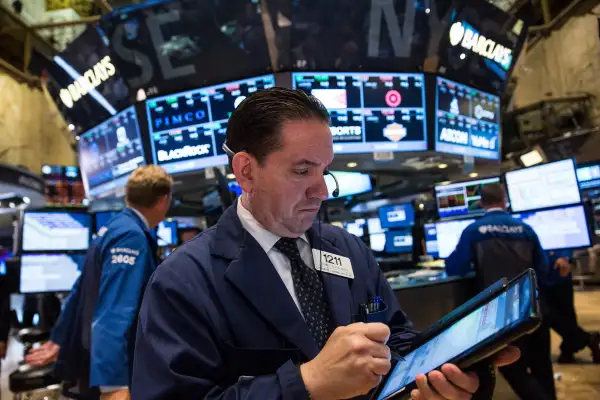Why Media Stocks Are Taking a Beating
Money is not a client of any investment adviser featured on this page. The information provided on this page is for educational purposes only and is not intended as investment advice. Money does not offer advisory services.

These are tough times in the pay-TV market, with fierce competition among providers and accelerating "cord cutting" by consumers shrinking the traditional pay-TV pie. Over the past week, investor concerns over these dynamics finally caught up with media stock prices.
The catalyst was guidance by Walt Disney executives who spooked the market with comments Thursday that their cable networks group (which includes ESPN) would underperform earnings estimates for the upcoming year. On top of that, Viacom reported declines in profits and revenues. Other media stock earnings have been generally solid but below expectations.
The stream of disappointing news unleashed a huge selloff in media stocks. Two days after Disney's announcement, Disney shares were down by 11%, Fox fell 13%, Time-Warner sank 10%, and Viacom dropped a whopping 21%. Comcast and CBS fell 6% and 1% respectively. Discovery Communications dropped 9%. The S&P 500 media index lost 8.2% overall for its largest two-day drop in over six and a half years.
As a result, billions in market value were wiped out in a matter of days. Bloomberg noted that between Disney, Time Warner, CBS, Fox, and Comcast, nearly $50 billion of market value was lost during that two-day period. Was this selloff justified, or simply a market overreaction?
Decent Results but High Expectations
A partial selloff, if not a full-blown correction, seemed overdue within the sector. Media shares have been a huge driver of the broader bull market, rising over 500% during the current bull run. That outperformed banking, retailing, auto manufacturing, and most other sectors. According to Bloomberg, last week’s selloff knocked the price-to-earnings (P/E) ratio of media stocks down to around 18.8, bringing it more or less in line with the general market.
Another factor contributing to the slide is that media stocks are a favorite of hedge fund and mutual fund managers, who are inclined to be quick on the sell trigger. However, there have been signs for several years that the traditional pay-TV model was entering a period of transition and disruption, if not immediate decline.
Disney executives acknowledged in a conference call that cable and satellite subscriptions are down — as Disney CEO Robert Iger pointed out, "We're realists about the business." Iger doesn't see streaming outlets offering smaller, targeted bundles or a la carte channels as an immediate threat, but would contemplate different options for ESPN if traditional pay TV outlets continue to slide, including "going direct to customers."
Understandably, the cable and satellite companies are dismayed at that concept. Charter Communications chief executive Thomas Rutledge said that networks providing a la carte offerings to the streaming services have "devalued their core product, and they may or may not be carried in the future as a result of that."
Investors may be wondering: if the mighty ESPN is not enough to keep subscribers on traditional pay TV packages, what will? Even if the current selloff is a bit of an overreaction, that is a fair and reasonable question.
It's All About Leverage
There has certainly been a desire among consumers for smaller TV bundles or a la carte channels, and now the technology exists to make it happen in a practical way. With this new paradigm available, who has the leverage?
Recent mergers and consolidations within the media sector are an attempt to boost leverage — and the pay-TV component is just one part of that leverage. Companies that own desirable content and control both means of delivering it to customers (traditional cable/satellite packages and high-speed Internet connections) can afford to let things play out and pivot toward the more profitable technology as late as possible.
It's not a given that a la carte or smaller bundle services will completely kill traditional pay TV. Streaming depends on available and affordable high-speed Internet access, and higher demand for that access is likely to strain those systems and drive up prices (even if net neutrality is retained). Meanwhile, it seems likely that satellite and cable systems are going to have to come up with some creative smaller bundles to compete, whether they like it or not.
Smaller, independent content providers may be in the toughest position. They have to make a choice, or risk being shut out of certain outlets for their content. Conversely, larger content providers may eventually be in a position to apply leverage. What are the odds that Charter would refuse to carry ESPN and Disney properties if push comes to shove?
The Takeaway
Last week's media selloff, while likely overdue, does not spell the end of opportunity to make money in this sector. Nevertheless, it should give investors motivation to rethink where media stocks fit into their current portfolios.
What individual media companies are you invested in, and how are they likely to fare in the transition to the new TV landscape? Do these companies have their own means of delivery or the overall clout to develop or acquire them? Are they diversified enough that losses in one area can be compensated for by gains in other divisions?
Many media stocks retain strong fundamentals, but they probably won't regain their status as mutual/hedge fund favorites until the current disruption reaches a clearer equilibrium point. As an individual investor, beware getting caught up in a stampede of selling when the fundamentals of your chosen stocks remain solid. With proper analysis, you may even find relative bargains in solid companies during a general downturn.
At the end of the day, it all comes down to leverage. Do the media companies in your portfolio have it, and does the news of the day cause your companies to either gain or lose that leverage? Assess the individual company’s risk and value, and act accordingly.
More From MoneyTips: